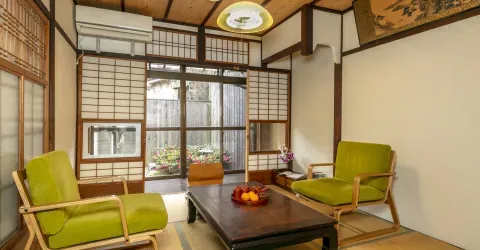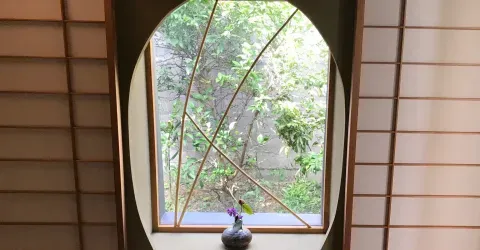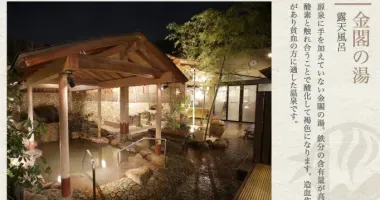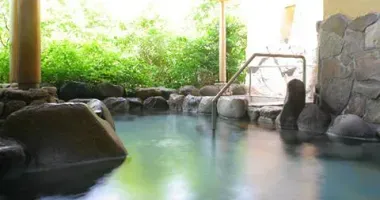Onsen Kyoto: Your Guide to the Best Hot Springs in Japan's Ancient Capital
- Published on : 19/02/2024
- by : Japan Experience
- Youtube
What is an onsen and why visit one in Kyoto?
An onsen is a natural hot spring bath with water typically between 38 and 43 degrees Celsius, rich in mineralslike sulfur, calcium, and sodium. To be certified as an onsen in Japan, the water must come from a geothermal spring and contain at least one of 19 designated chemical elements.
Soaking in an onsen is believed to have various health benefits, such as relieving muscle pain, improving circulation, and promoting healthy skin. Different springs are said to target specific ailments based on their unique mineral composition.
Kyoto's serene temples, stunning gardens and rich history pair perfectly with a rejuvenating onsen visit.After a day exploring sights like Kiyomizu-dera or the Bamboo Grove, sinking into a steaming mineral bath surrounded by nature is pure bliss.
Onsen etiquette for first-timers
Going to an onsen for the first time can feel intimidating, but armed with some key tips, there's nothing to worry about:
- No clothing or swimsuits allowed: Everyone soaks nude to avoid contaminating the water. Small towels are provided for modesty.
- Wash thoroughly before entering: Use the shower area to clean your body with soap. Tie long hair up and don't let your towel touch the water.
- Avoid disturbing others: Speak quietly, don't stare, and skip the phone. Let tranquility reign.
- Tattoos may need to be covered: Many onsens don't allow visible tattoos due to yakuza associations. Tattoo-friendly options do exist though.
Best onsen in Kyoto city
Kurama Onsen is a scenic outdoor bath nestled in a charming village just 30 min from central Kyoto. Surrounded by forest, its mineral-rich waters are said to help with conditions like diabetes and muscle pain. Access it via a short hike or free shuttle bus.
Tenzan-no-yu is an expansive onsen complex with indoor/outdoor baths, saunas, a restaurant and entertainment. Its waters come from over 1km underground. A fish bath where tiny fish nibble your feet is a quirky highlight.
Funaoka Onsen is a historic bathhouse dating back to 1923. While not a true onsen, its distinctive wooden building, ornate tile work and variety of baths (including a small outdoor garden tub) make it a local favorite.
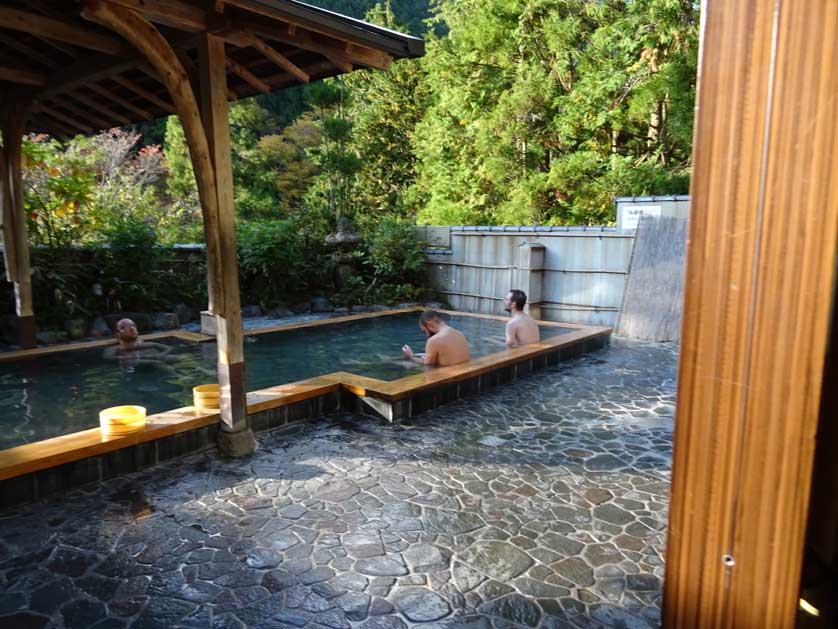
Kurama Onsen, Kyoto
Top onsen ryokan stays in Kyoto
For the ultimate immersion, stay at a ryokan (traditional inn) with its own hot springs. Ryokans deliver impeccable service, luxurious yet authentic rooms, and multi-course kaiseki dining showcasing Kyoto's famed cuisine.
Look for ryokans with a variety of baths like scenic outdoor tubs, gender-segregated public baths, and "family baths" you can reserve for private soaking. Many ryokans also offer in-room onsens so you can take a mineral soak mere steps from your futon.
Top picks include Arashiyama's Togetsutei Ryokan, with open-air baths facing the forest, and Momijiya Ryokan in Takao, where all rooms have a private hinoki wood tub. Kurama Onsen Ryokan is another gem for its serene riverside setting.
Onsen day trips from Kyoto
Arima Onsen in Kobe is one of Japan's oldest hot spring towns, just a 90 min journey from Kyoto. Its quaint streets are lined with traditional inns, many offering day-use baths. Two unique spring types flow here - clear "silver" and reddish-brown "gold" waters.
Kinosaki Onsen is a picturesque onsen town 2.5 hours north of Kyoto. Guests staying at a ryokan get free access to seven lovely public bathhouses to onsen-hop to their heart's content. Evenings are magical, with people strolling the canal-lined streets in colorful yukata robes.
On the Pacific coast 3 hours south of Kyoto, Shirahama Onsen is a hot spring resort known for its beautiful white sand beach. Several seafront ryokan feature onsen with stunning ocean panoramas. Coastal baths warmed by the sun are extra relaxing.
Visiting an onsen in each season
Japanese onsens take on a special character with the changing seasons:
In spring, baths framed by billowing cherry blossoms are breathtaking. Summer sees lively festivals and fireworks reflected in the steaming pools. Autumn turns the surrounding maples vivid crimson and gold. And in winter, snowflakes dance down on open-air tubs in an enchanting scene.
Seasonal treats served after bathing are another delight. Savor refreshing chilled noodles and crisp beer in summer, or warm up with oden hot pot and sake in winter. Look out for special illuminations around outdoor baths during hanami and autumn leaf seasons.
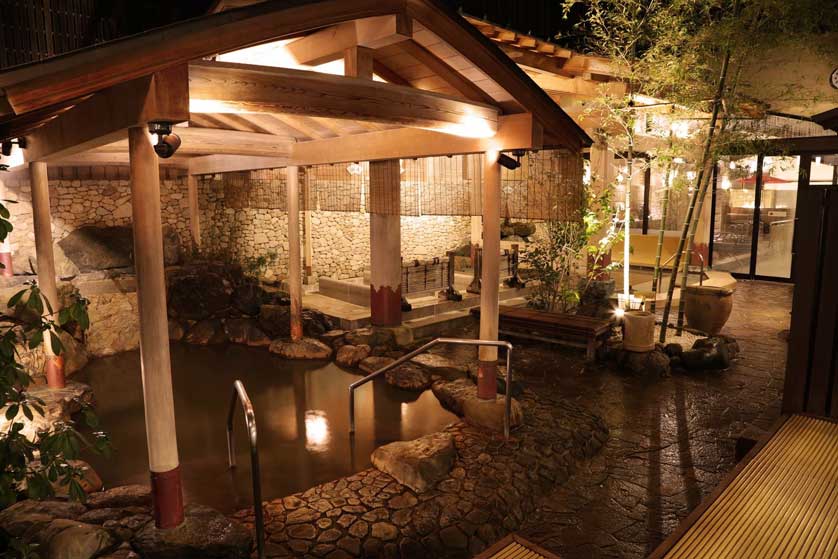
© Tenzan-no-yu (天山の湯)
Kyoto onsen experiences to remember
For something different, seek out Kyoto's unique onsen facilities like the carbonated springs at Tenzan-no-yu or Funaoka's rare electric bath. Booking a private rental onsen lets you soak together as a couple or family, while onsen theme parks offer a fun variety of baths and entertainment.
One of the most memorable ways to onsen in Kyoto is in an outdoor bath with a view. Gaze over the glittering city lights, contemplate a lush valley hugged by curling mist, or relax under the stars to the gentle burble of the Kamo River. These quiet, intimate moments define the magic of onsen culture.
With its beguiling blend of history, natural beauty, and Kyoto charm, an onsen trip leaves you soothed to your core. Whether it's a day visit from the city or a luxurious ryokan stay in the mountains, soaking in Kyoto's mineral-rich waters is sure to be a highlight of your time in Japan's ancient capital.
Kyoto is renowned for its temples, gardens and traditional culture, but it also offers a relaxing onsen experience. Onsens are natural hot spring baths, an essential part of Japanese culture and a must-try for visitors. While Kyoto has fewer onsen options than some parts of Japan, there are excellent choices in and near the city.
